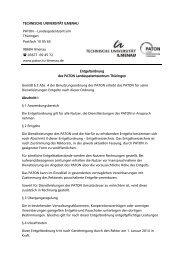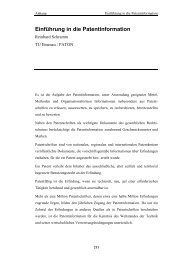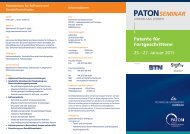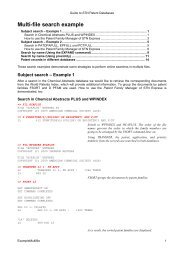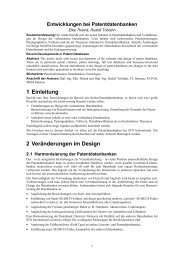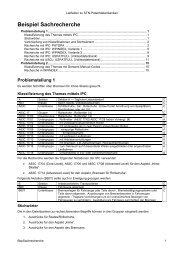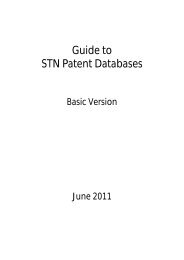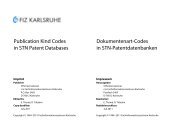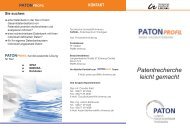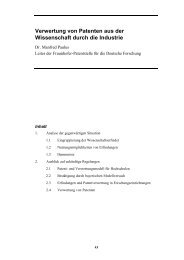Guide to STN Patent Databases – Basic Version - Paton - TU Ilmenau
Guide to STN Patent Databases – Basic Version - Paton - TU Ilmenau
Guide to STN Patent Databases – Basic Version - Paton - TU Ilmenau
Create successful ePaper yourself
Turn your PDF publications into a flip-book with our unique Google optimized e-Paper software.
Types of search<br />
22.5.6 Conclusion for INPADOCDB, DWPI, HCAplus<br />
If it is vital <strong>to</strong> obtain a fully comprehensive patent family all three family data bases should be searched. Due <strong>to</strong> the<br />
different country coverage, different definitions of what a patent family is, different timeliness of patent<br />
publications being entered in<strong>to</strong> the databases and different time coverage of the databases the publications<br />
considered members of a given patent family varies in the three databases.<br />
22.6 Non-conventional patent families<br />
A non-conventional patent family combine applications that have the same or similar technical contents but do not<br />
refer <strong>to</strong> each other. The applicant/patent assignee and inven<strong>to</strong>rs may be the same or different (competi<strong>to</strong>rs). Such<br />
similar applications may be granted if:<br />
There is no publication of the equivalent in any other country (unpublished applications are only relevant<br />
<strong>to</strong> novelty and only if relating <strong>to</strong> the same geographical area),<br />
Two or more equivalent applications are filed on the same day.<br />
These non-conventional families can usually be found by a subject search, name search, etc.<br />
Owing <strong>to</strong> the patent strategies of companies it may be that two equivalent applications are filed on one day. Using<br />
the internal priority e.<br />
the other.<br />
To specifically find these non-conventional families, which are not linked by common priorities it may be useful <strong>to</strong><br />
search for applications by the applicant concerned of the same day.<br />
Two A1 publications oft he same day, but with different<br />
priorities the documents belong <strong>to</strong> two different families.<br />
L4 ANSWER 1 OF 4 INPADOCDB COPYRIGHT 2010 EPO/FIZ KA on <strong>STN</strong><br />
FN 37910144<br />
TI Funkenstreckenanordnung fuer hoehere Bemessungsspannungen.<br />
PAS DEHN & SOEHNE, DE<br />
PI DE 102008049471 A1 20091112<br />
PIT DEA1 DOC. LAID OPEN (FIRST PUBLICATION)<br />
AI DE 2008-102008049471 A 20080929<br />
AIT DEA <strong>Patent</strong> application<br />
PRAI DE 2007-102007049319 A 20071015 (DEA1, 20090507, Y)<br />
DE 2008-102008049471 A 20080929 (DEA, 20090507, Y)<br />
PRAIT DEA1 Domestic priority claimed for patent<br />
L4 ANSWER 3 OF 4 INPADOCDB COPYRIGHT 2010 EPO/FIZ KA on <strong>STN</strong><br />
FN 37899658<br />
TI Funkenstreckenanordnung fuer hoehere Bemessungsspannungen.<br />
PAS DEHN & SOEHNE, DE<br />
PI DE 102008049458 A1 20090430<br />
PIT DEA1 DOC. LAID OPEN (FIRST PUBLICATION)<br />
AI DE 2008-102008049458 A 20080929<br />
AIT DEA <strong>Patent</strong> application<br />
PRAI DE 2007-102007049403 A 20071015 (DEA1, 20090430, Y)<br />
DE 2008-102008049458 A 20080929 (DEA, 20090430, N)<br />
PRAIT DEA1 Domestic priority claimed for patent<br />
22.7 Notes on other databases<br />
22.7.1 PATDPA<br />
Whether the contents of both documents are actually the same<br />
needs <strong>to</strong> be thoroughly examined. At least the similar<br />
application should be found.<br />
The PATDPA database contains publications of three patent organizations: DPMA, EPO, WIPO. Every application <strong>to</strong><br />
one of these organizations (or rather the resulting first publication) triggers a new record in PATDPA <strong>to</strong> be opened<br />
and updated by the publications of the respective patent office. Thus, there may be more than one record in the<br />
database for the same patent family (for DE, EP, and WO). Additionally, all publications of the patent family are<br />
added <strong>to</strong> the family field of each record.<br />
159



